Top 12 Best AI APIs to Use in [2024]
The AI revolution is here, and if you're not harnessing its power, you're missing out. Imagine effortlessly integrating cutting-edge AI capabilities into your projects, no PhD required. That's the magic of AI APIs.
In this guide, we'll discuss everything about AI APIs and reveal the top 12 contenders you need to know in 2024. We'll cover:
Demystifying AI APIs: What they are and how they work
Why AI APIs are your secret weapon for innovation
The crème de la crème: 12 AI APIs poised to transform your projects
Choosing the perfect API: A roadmap for success
Real-world applications: See how AI APIs are changing the game
Oh, and did we mention API League has a few tricks up its sleeve to make your AI journey even smoother? More on that later...
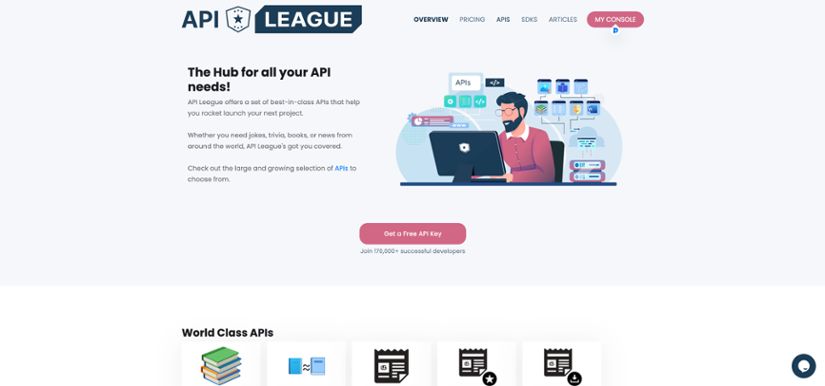
What Is an AI API?
Ever wished you could sprinkle a dash of artificial intelligence into your projects without needing a PhD in machine learning? Enter AI APIs, your backstage pass to the AI revolution.
In a nutshell, an AI API (Application Programming Interface) is a set of pre-built AI tools you can plug directly into your software. It's like ordering takeout from a Michelin-star restaurant - all the flavor, none of the cooking. You simply send a request to the API (think: "translate this text" or "generate an image of a cat wearing a hat"), and it serves up the results, fast.
No need to understand the complex algorithms or massive datasets working behind the scenes. AI APIs do the heavy lifting, so you can focus on building awesome applications.
How Do AI APIs Work?
Behind the scenes, AI APIs are powered by sophisticated machine-learning models and vast datasets. Let's break down the process:
Request: You send your data (text, image, etc.) to the API, along with instructions for the desired task.
Preprocessing: The API cleans and prepares your data for analysis.
Analysis: The AI model, trained on massive datasets, processes your data and applies its learned patterns to extract insights or generate outputs.
Postprocessing: The API refines the results for a user-friendly format.
Response: You receive the results, ready to be integrated into your application.
Think of it like a highly skilled chef transforming your raw ingredients into a culinary masterpiece. You don't need to know the exact recipe or cooking techniques; you simply enjoy the delicious result.
Types of AI APIs
AI APIs come in various flavors, each catering to specific tasks:
Natural Language Processing (NLP) APIs: These power chatbots, language translation, sentiment analysis, and more.
Computer vision APIs: Image and optical character recognition, object detection, and even facial analysis are made possible by these APIs.
Speech recognition APIs: These convert spoken words into text, enabling voice assistants and transcription services.
Recommendation engine APIs: Ever wondered how Netflix suggests what to watch next? That's the magic of recommendation engine APIs.
And the list goes on...
The power of pre-trained models
One of the key advantages of AI APIs is their use of pre-trained models. These models have already learned from vast amounts of data, so you don't have to start from scratch. It's like having a seasoned expert on your team, ready to share their knowledge.
API League: Your AI toolkit
API League's extensive collection of AI APIs gives you access to these pre-trained models, allowing you to tap into the power of AI without the hassle of building and training your own. With a few lines of code, you can integrate these APIs into your applications and unlock a world of possibilities.
12 Best AI APIs to Skyrocket Your Projects in 2024
Ready to infuse your applications with the power of AI? Here are 12 top-tier APIs that are changing the game in 2024, starting with a powerhouse you might already know...
1. OpenAI API
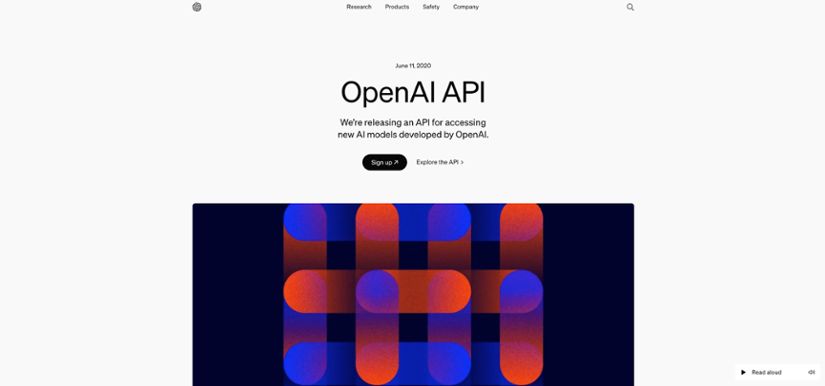
If you've ever been wowed by AI-generated text, chances are you've encountered the work of OpenAI's GPT (Generative Pre-trained Transformer) models. The OpenAI API grants you access to this cutting-edge technology, allowing you to harness the power of GPT-3 and beyond.
OpenAI API is a suite of tools that allows developers to integrate state-of-the-art language models into their applications. These models can perform a wide range of tasks, from text generation and translation to code completion and conversation.
Why OpenAI API?
State-of-the-art language models: OpenAI's GPT models are renowned for their ability to generate human-like text, making them ideal for chatbots, content creation, and more.
Versatility: OpenAI API offers models for various tasks, including language translation, summarization, question answering, and text completion.
Ease of use: The API is well-documented and easy to integrate into your existing workflows.
Active development: OpenAI is constantly pushing the boundaries of AI research, so you can expect the API to evolve and improve over time.
Who is OpenAI API for?
OpenAI API caters to a wide range of users, including:
Developers: Build innovative applications powered by cutting-edge AI.
Researchers: Explore the possibilities of language models and contribute to the field of AI.
Businesses: Improve customer service, streamline content creation, and gain valuable insights from data.
2. Google Cloud AI
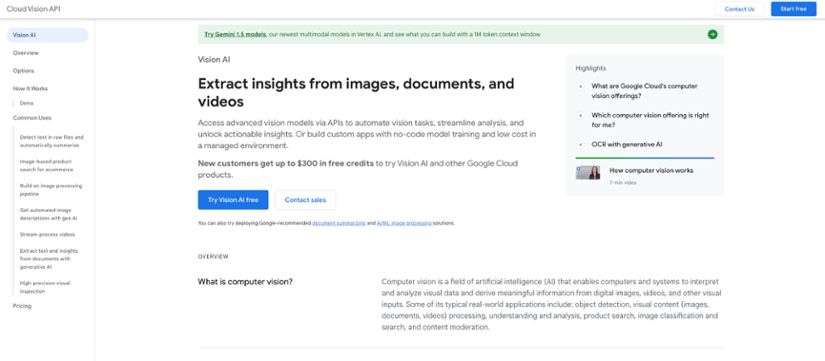
When it comes to AI, Google is a major player, and their Google Cloud AI platform is a testament to their expertise. This suite of AI tools offers a wide array of services, from natural language processing and computer vision to speech recognition and machine learning.
Google Cloud AI is a comprehensive collection of AI tools and services designed to help developers and businesses build intelligent applications. It offers pre-trained models, custom model-building tools, and end-to-end solutions for various use cases.
Why Google Cloud AI?
Wide range of services: Google Cloud AI covers a broad spectrum of AI capabilities, from text analysis to image recognition and video processing.
Powerful pre-trained models: Leverage Google's expertise with pre-trained models for tasks like language translation, sentiment analysis, and object detection.
Custom model building: Build and train your own AI models using Google's robust infrastructure and tools.
Scalability: Google Cloud AI can handle everything from small-scale projects to massive enterprise workloads.
Integration with Google Cloud: Seamlessly integrate AI into your existing Google Cloud applications and services.
3. API League

API League isn't your average API provider. It's a comprehensive platform packed with a diverse range of AI capabilities. Think of it as your AI Swiss Army knife, ready to tackle any project you throw at it.
API League offers a vast collection of APIs, catering to various AI needs. Whether you're looking for Natural Language Processing (NLP) tools, image recognition, sentiment analysis, or even fun APIs for jokes and memes, API League has you covered.
Why API League?
Wide range of APIs: From text analysis to image generation, API League has it all.
Developer-friendly: Get started quickly with comprehensive documentation, example code, and SDKs in multiple programming languages.
Scalable: API League's flexible plans grow with your needs, from hobby projects to enterprise-level applications.
Reliable: Count on API League for high uptime and responsive support.
Affordable: API League offers competitive pricing and even a free tier to get you started.
Community-driven: API League continuously evolves based on user feedback, ensuring it always delivers the tools developers need.
4. Amazon Web Services (AWS) AI Services
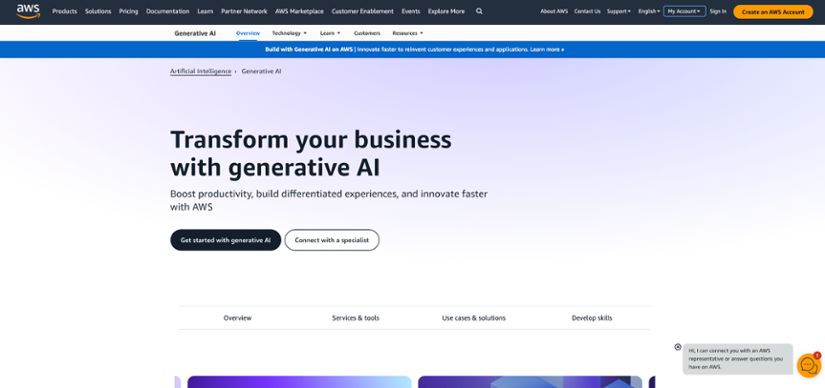
Amazon Web Services (AWS) is a leading cloud computing platform, and their AI services are a natural extension of their cloud offerings. AWS AI Services provide a comprehensive suite of AI tools and services for developers and businesses of all sizes.
AWS AI Services encompass a wide range of AI capabilities, including machine learning, natural language processing, computer vision, and more. These services are designed to be easy to use, scalable, and cost-effective.
Why AWS AI Services?
Broad range of services: AWS AI Services cover a vast array of AI use cases, from chatbots and personalization to fraud detection and forecasting.
Pre-trained models and custom solutions: Choose from pre-trained models or build and train your own using AWS's robust infrastructure.
Scalability and performance: AWS AI Services are built for the cloud, so you can scale your AI workloads up or down as needed.
Integration with AWS ecosystem: Seamlessly integrate AI into your existing AWS applications and services.
Pay-as-you-go pricing: Only pay for the AI resources you use, making it a cost-effective option for businesses of all sizes.
5. IBM Watson
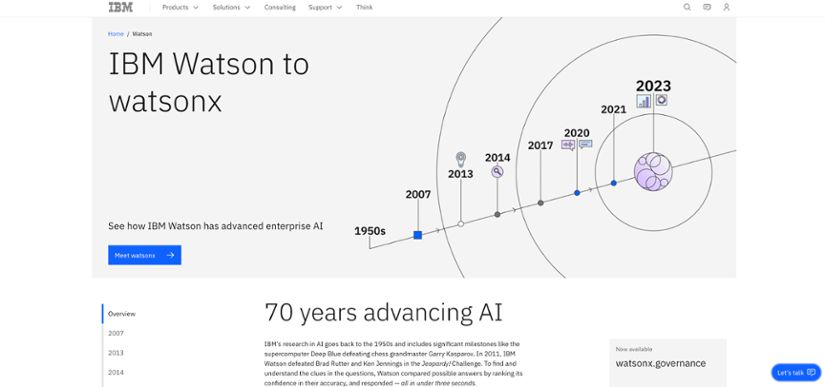
IBM Watson has been a pioneer in the AI space, offering a suite of enterprise-grade AI solutions for businesses across various industries. With a focus on natural language processing, Watson excels at understanding and processing human language, making it a valuable tool for tasks like chatbots, sentiment analysis, and data extraction.
IBM Watson is a collection of AI services and tools designed for businesses. It includes pre-trained models for natural language processing, computer vision, and machine learning, as well as tools for building custom AI solutions.
Why IBM Watson?
Natural Language Processing (NLP) expertise: Watson is renowned for its NLP capabilities, making it ideal for tasks like chatbots, content analysis, and language translation.
Industry-specific solutions: Watson offers tailored solutions for industries like healthcare, finance, and customer service.
Custom model building: Build and train your own AI models using Watson's tools and infrastructure.
Enterprise-grade security: Watson prioritizes data security and compliance, making it a trusted choice for businesses.
Integration with IBM Cloud: Seamlessly integrate Watson into your existing IBM Cloud applications and services.
6. Microsoft Azure Cognitive Services
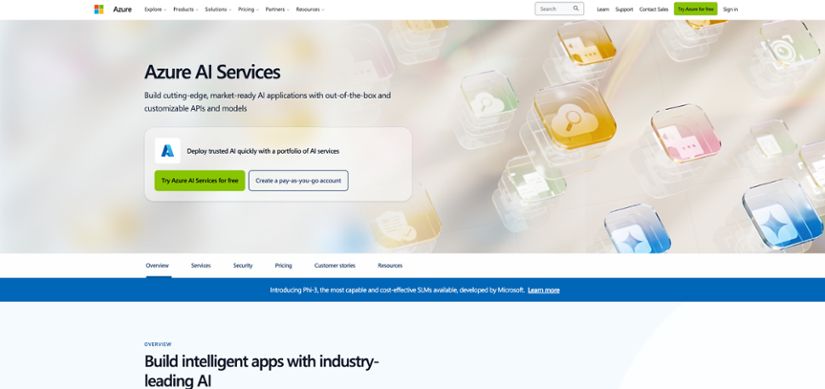
Microsoft Azure Cognitive Services is a collection of AI APIs that empower developers to build intelligent applications without needing deep AI expertise. With a focus on ease of use and accessibility, Azure Cognitive Services offers a wide range of pre-trained models for tasks like vision, speech, language, and decision-making.
Azure Cognitive Services is a set of APIs that provide access to pre-trained AI models for various tasks. These APIs can be easily integrated into your applications, allowing you to add AI capabilities without building your own models.
Why Microsoft Azure Cognitive Services?
Comprehensive AI capabilities: Azure Cognitive Services covers a broad spectrum of AI tasks, from image recognition and text analysis to speech synthesis and translation.
Easy integration: The APIs are designed to be developer-friendly, with clear documentation and examples.
Scalability: Azure Cognitive Services can handle large volumes of data and scale to meet your needs.
Integration with Azure Cloud: Seamlessly integrate AI into your existing Azure Cloud applications and services.
Cost-effective: Azure Cognitive Services offers flexible pricing options to suit your budget.
7. Hugging Face Transformers
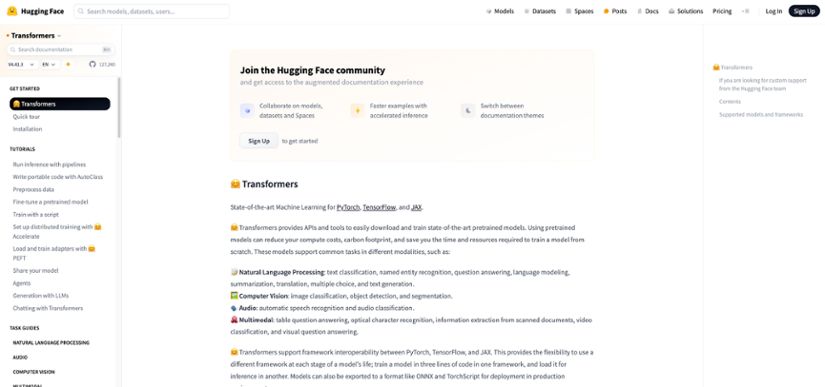
If you're knee-deep in natural language processing (NLP) projects, Hugging Face Transformers is your new best friend. This open-source library provides thousands of pre-trained models for tasks like text classification, question answering, translation, and text generation. It's like having a whole team of NLP experts at your disposal.
Hugging Face Transformers is a library built on top of the popular PyTorch machine-learning framework. It offers a vast collection of pre-trained models, as well as tools for fine-tuning and deploying your own custom models.
Why Hugging Face Transformers?
Extensive Model Library: Choose from thousands of pre-trained models for various NLP tasks.
Community-Driven: The Hugging Face community is incredibly active, constantly contributing new models and improvements.
Easy to Use: The library is well-documented and easy to integrate into your Python projects.
Customization: Fine-tune existing models or build your own from scratch using the provided tools.
Open Source: Hugging Face Transformers is free and open-source, making it accessible to everyone.
8. Deepgram
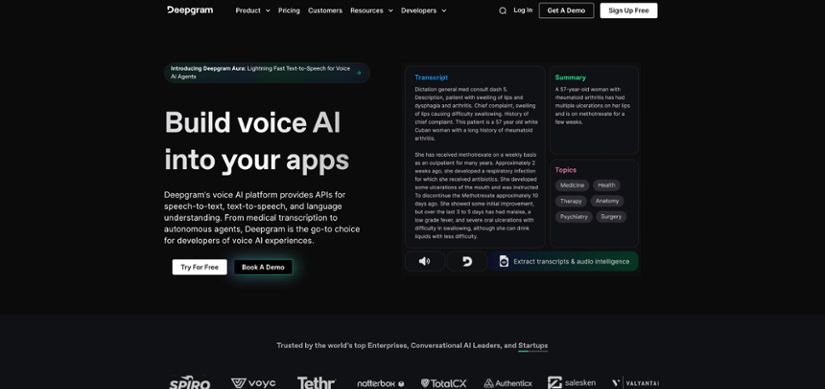
Voice is the future of human-computer interaction, and Deepgram is at the forefront of this revolution. Their speech recognition API boasts impressive accuracy and a wide range of features, making it ideal for applications like transcription, voice assistants, and call center predictive analytics.
Deepgram is a cloud-based speech recognition platform that uses deep learning to transcribe and analyze spoken language. It offers a range of features, including real-time transcription, speaker diarization, and sentiment analysis.
Why Deepgram?
High accuracy: Deepgram's models are trained on massive datasets and consistently outperform competitors in accuracy tests.
Real-time transcription: Get transcriptions in real-time, ideal for live events or call center monitoring.
Customization: Train custom models tailored to your specific use case, such as industry jargon or accents.
Speaker diarization: Identify and track individual speakers in a conversation, making it easier to analyze multi-person interactions.
Sentiment analysis: Gain insights into the emotions expressed in spoken language.
9. Clarifai
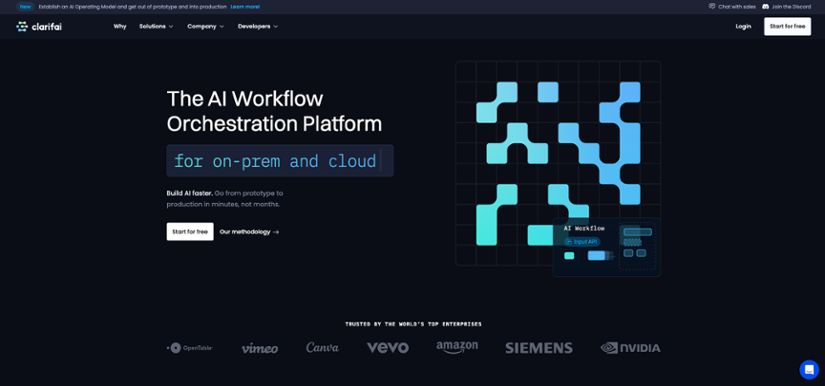
If a picture is worth a thousand words, Clarifai's visual AI platform helps you understand each one. With robust image and video recognition capabilities, Clarifai empowers you to build applications that "see" the world, from moderating content to powering visual search engines.
What is Clarifai?
Clarifai is a leading visual AI platform that allows you to easily organize, analyze, and extract valuable insights from images and videos. Their API offers a range of pre-trained models and custom model training options, making it a versatile tool for various visual AI applications.
Why Clarifai?
Powerful image and video recognition: Clarifai's models can identify objects, scenes, concepts, and even emotions within visual content.
Custom model training: Train your own AI models to recognize specific objects or patterns tailored to your needs.
Easy integration: Clarifai's API is well-documented and easy to integrate into your applications.
Scalability: Clarifai can handle large volumes of visual data and scale to meet your growing needs.
Wide range of applications: Use Clarifai for content moderation, visual search, product recommendations, and more.
10. AssemblyAI
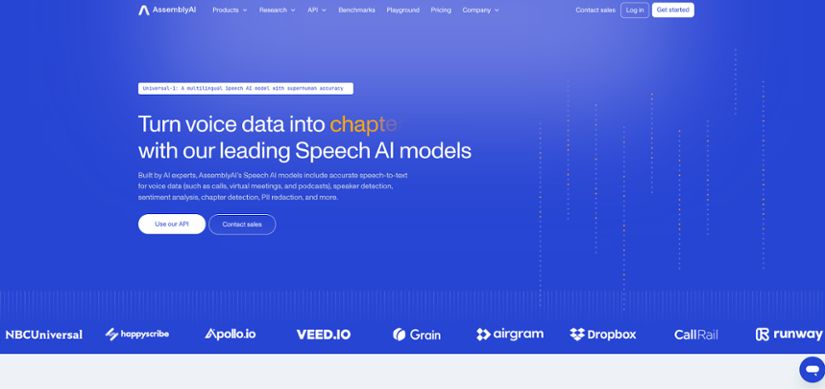
Audio data holds a wealth of information, but extracting it can be a challenge. AssemblyAI simplifies the process with its powerful speech-to-text API. Whether you need to transcribe meetings, podcasts, or customer calls, AssemblyAI delivers accurate and reliable results.
AssemblyAI is a cloud-based platform that offers a range of speech-to-text APIs. Their core API converts audio files into text, while additional features like summarization and topic detection add even more value.
Why AssemblyAI?
Accurate Transcriptions: AssemblyAI's models are trained on diverse datasets, ensuring high accuracy across various accents and audio qualities.
Real-Time Transcription: Get transcriptions in real-time, perfect for live events or call center monitoring.
Customization: Train custom models tailored to your specific use case, such as industry jargon or speaker characteristics.
Additional Features: Go beyond transcription with features like summarization, topic detection, and content moderation.
11. Replicate
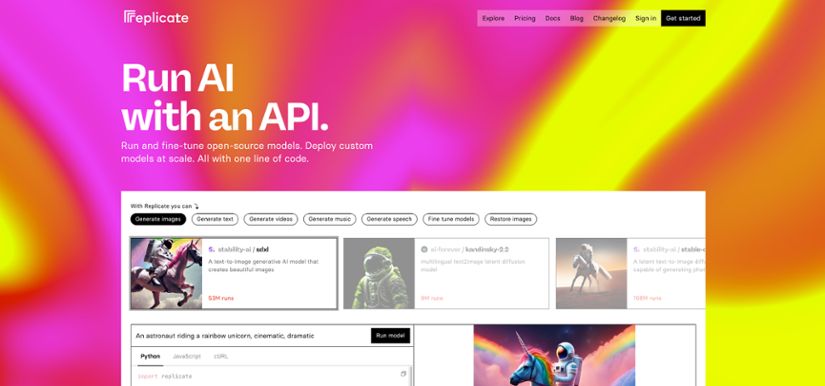
Replicate is a dream come true for developers who want to experiment with cutting-edge AI models without the hassle of managing complex infrastructure. This platform allows you to run open-source AI models in the cloud, making it easy to prototype, test, and deploy AI applications.
Replicate is a cloud-based platform that lets you run machine learning models with a simple API. It provides access to a wide range of open-source models for tasks like image generation, style transfer, and super-resolution.
Why Replicate?
Vast model library: Replicate offers a growing collection of open-source AI models, covering various domains and use cases.
Ease of use: With a simple API and intuitive interface, Replicate makes it easy to get started with AI, even if you're not a machine learning expert.
Scalability: Replicate's cloud infrastructure can handle demanding workloads, so you can scale your AI applications as needed.
Community-driven: Replicate encourages collaboration and contributions from the open-source community, fostering innovation and continuous improvement.
12. RunwayML
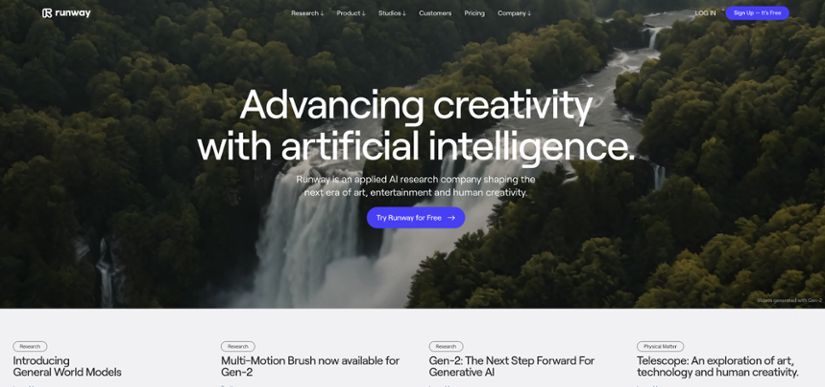
RunwayML is a platform designed for artists, designers, and creatives who want to explore the creative potential of AI. It offers a suite of intuitive tools and models for tasks like image generation, video editing, and even music composition.
RunwayML is a no-code platform that makes AI accessible to creatives. It provides a user-friendly interface for interacting with AI models, as well as tutorials and resources to help you get started.
Why RunwayML?
Creative focus: RunwayML is specifically designed for artists and designers, with tools and models tailored to creative workflows.
Intuitive interface: The platform's no-code interface makes it easy to experiment with AI, even if you don't have extensive machine learning expertise.
Wide range of creative tools: RunwayML offers tools for image generation, video editing, style transfer, and more.
Collaboration: Collaborate with other creatives on projects and share your work with the community.
Education: RunwayML provides tutorials and resources to help you learn about AI and its creative applications.
Choosing Your AI Ally: A Comparison of the Top APIs
With so many powerful AI APIs at your fingertips, which one is right for your project? Let's break it down with a side-by-side comparison of the key features, strengths, and ideal use cases for each API.
| AI API | Key Features | Strengths | Ideal Use Cases |
|---|---|---|---|
| API League | Diverse collection, developer-friendly, scalable, reliable, affordable, community-driven | One-stop shop for various AI needs, easy to integrate, flexible plans, high uptime, competitive pricing, continuous improvement based on user feedback | Text analysis, image generation, sentiment analysis, jokes/memes, and more |
| OpenAI API | State-of-the-art language models, versatile, easy to use, active development | Powerful text generation, wide range of NLP tasks, user-friendly API, constantly evolving with new features and improvements | Chatbots, content creation, language translation, summarization, question answering, code completion |
| Google Cloud AI | Wide range of services, powerful pre-trained models, custom model building, scalability, integration | Comprehensive AI platform, robust infrastructure, expertise in various AI domains, seamless integration with Google Cloud ecosystem | Text analysis, image recognition, video processing, machine learning, and more |
| AWS AI Services | Broad range of services, pre-trained models and custom solutions, scalability, AWS integration | Extensive AI capabilities for various use cases, flexible options for model building, cloud-native scalability, seamless integration with AWS ecosystem | Chatbots, personalization, fraud detection, forecasting, and more |
| IBM Watson | NLP expertise, industry-specific solutions, custom model building, enterprise-grade security | Strong focus on natural language processing, tailored solutions for various industries, robust security measures, integration with IBM Cloud | Chatbots, content analysis, language translation, healthcare, finance, customer service |
| Microsoft Azure Cognitive | Comprehensive AI capabilities, easy integration, scalability, Azure integration | Wide range of pre-trained models for various tasks, developer-friendly APIs, scalable infrastructure, seamless integration with Azure Cloud | Image recognition, text analysis, speech synthesis, translation, and more |
| Hugging Face Transformers | Extensive model library, community-driven, easy to use, customization, open source | Vast collection of pre-trained NLP models, active community contributions, user-friendly, flexible customization options, accessible to everyone | Text classification, question answering, translation, text generation, and other NLP tasks |
| Deepgram | High accuracy, real-time transcription, customization, speaker diarization, sentiment analysis | State-of-the-art speech recognition, real-time results, custom model training, advanced features for analyzing multi-person conversations | Transcription, voice assistants, call center analytics, meeting analysis |
| Clarifai | Powerful image and video recognition, custom model training, easy integration, scalability | Robust visual AI capabilities, flexible options for model building, user-friendly API, handles large volumes of visual data | Content moderation, visual search, product recommendations, and more |
| AssemblyAI | Accurate transcriptions, real-time transcription, customization, additional features | Reliable speech-to-text conversion, real-time results, custom model training, features like summarization and topic detection | Transcription, meeting analysis, podcast transcription, content moderation |
| Replicate | Vast model library, ease of use, scalability, community-driven | Access to a wide range of open-source AI models, simple API and interface, scalable cloud infrastructure, collaboration and innovation through the open-source community | Image generation, style transfer, super-resolution, and other experimental AI applications |
| RunwayML | Creative focus, intuitive interface, wide range of creative tools, collaboration, education | Tailored for artists and designers, no-code interface, diverse creative AI tools, collaborative features, educational resources | Image generation, video editing, style transfer, music composition, and other creative AI applications |
Choosing Your Perfect AI API Match: Key Criteria to Consider
Now that you've met some of the top contenders in the AI API arena, how do you decide which one is your perfect match? Choosing the right API can make or break your project, so let's explore the key criteria to consider when making your decision.
Functionality and features
Does the API offer the specific capabilities you need? If you're building a chatbot, you'll need advanced natural language processing (NLP) capabilities. If object recognition is your goal, prioritize a natural language API with robust computer vision features.
Does the API provide pre-trained models or custom model building options? Pre-trained models can save you time and resources, but custom models may be necessary for highly specialized tasks.
What additional features does the API offer? Look for features like sentiment analysis, entity recognition, or even real-time transcription, depending on your project requirements.
Ease of use and integration
Is the API well-documented and easy to understand? Clear documentation and examples can significantly reduce the learning curve.
Does the API offer SDKs or libraries for your preferred programming language? SDKs can streamline the integration process and save you development time.
Is there a supportive community or forum for troubleshooting and assistance? A strong community can be invaluable when you encounter challenges.
Performance and scalability
How accurate and reliable is the API? Accuracy is crucial, especially for tasks like language translation or medical diagnosis.
How quickly does the API respond to requests? Real-time or near-real-time responses may be necessary for certain applications.
Can the API handle your expected workload and scale as your needs grow? Choose an API that can handle your current and future traffic volumes.
Cost and pricing
What is the API's pricing structure? Some machine learning APIs offer a free tier, while others charge based on usage or features.
Are there any hidden costs or fees? Be sure to read the fine print to avoid unexpected expenses.
Does the pricing align with your budget and project requirements? Choose an API that offers the best value for your investment.
Support and documentation
Does the API provider offer comprehensive documentation and tutorials? Good documentation is essential for understanding how to use the API effectively.
Is there a responsive support team available to help with issues or questions? Reliable support can save you time and frustration when problems arise.
Does the provider offer regular updates and improvements to the API? An API that is actively maintained is more likely to remain reliable and secure over time.
By carefully considering these criteria, you can confidently choose the AI API that best suits your project needs and sets you on the path to success.
Pro Tip: Don't hesitate to experiment with different APIs to find the one that fits your workflow and preferences. Many providers offer free trials or limited-use plans, allowing you to test the waters before committing.
AI APIs in Action: Real-World Applications
AI APIs are not just theoretical tools; they're actively transforming industries and powering innovative applications across the board. Let's dive into some real-world examples of how these APIs are being used to solve problems, improve efficiency, and create new possibilities.
Customer service and chatbots
AI-powered chatbots are revolutionizing customer service, providing 24/7 support, answering FAQs, and even resolving complex issues. NLP APIs like those from OpenAI and IBM Watson enable these chatbots to understand natural language, engage in meaningful conversations, and deliver personalized assistance.
Content creation and marketing
AI APIs are becoming indispensable for content creators and marketers. Tools like OpenAI's GPT-3 can generate images and high-quality articles, blog posts, and social media content, saving time and resources. Clarifai's visual AI can help marketers analyze images and videos to gain insights into customer preferences and tailor their campaigns accordingly.
Healthcare and medical diagnosis
AI APIs are making significant strides in healthcare, assisting with medical image analysis, drug discovery, and even patient diagnosis. Google Cloud AI and AWS AI Services offer powerful tools for analyzing medical images, identifying patterns, and predicting patient outcomes.
Finance and fraud detection
In the financial sector, artificial intelligence APIs are used for fraud detection, risk assessment, and algorithmic trading. AWS AI Services and IBM Watson provide robust solutions for analyzing financial data, identifying anomalies, and making informed decisions.
Education and personalized learning
AI APIs are transforming education by enabling personalized learning experiences. Microsoft Azure Cognitive Services can analyze student data to identify learning patterns and recommend tailored content, while AssemblyAI can transcribe lectures and create accessible learning materials.
Other applications
The possibilities are truly endless. AI APIs are being used for:
Language translation (e.g., Google Cloud Translation API)
Sentiment analysis (e.g., API League Sentiment Analysis API)
Image and video generation (e.g., RunwayML, Replicate)
Voice assistants (e.g., Deepgram, AssemblyAI)
Recommendation systems (e.g., Amazon Personalize)
Pro Tip: When choosing an AI API, consider the specific use cases you have in mind. Each API has its strengths and weaknesses, so choose the one that aligns best with your project goals.
As AI technology continues to advance, we can expect even more innovative and impactful applications of AI APIs in the future. By embracing these tools, businesses and developers can unlock new levels of efficiency, creativity, and problem-solving.
Ready, Set, AI with API League
There you have it, the top 12 AI APIs primed to revolutionize your projects in 2024. Whether you're a seasoned developer or just dipping your toes into the AI waters, these tools are your ticket to building smarter, more innovative applications.
Your key takeaways:
AI APIs are your secret weapon: Harness the power of AI without needing a PhD.
Choose wisely: Consider your specific needs and project requirements when selecting an API.
The future is AI: Embrace the potential of AI to transform your work and drive innovation.
Speaking of embracing AI, API League's comprehensive suite of APIs and developer-friendly SDKs are your trusty companions on this exciting journey. With a vast array of AI capabilities at your fingertips, you're well-equipped to turn your wildest ideas into reality. Why not give API League a try and see how it can elevate your projects to new heights?